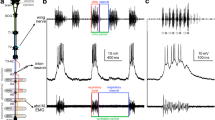Abstract
Studies on cats anesthetized with a mixture of Nembutal and chloralose were performed to study the descending influences of single, paired, and frequent stimulation of the lateral septal nucleus (LSN) and bed nucleus of the stria terminalis (BNST) on the activity of viscerosensory neurons in the solitary tract nucleus, identified by stimulation of the cervical part of the vagus nerve. Of 70 units recorded in the solitary tract nucleus, 50 were identified as primary and secondary input vagus neurons. Single stimuli applied to the septal nuclei induced initial excitation in 30% (15 units) of vagus neurons. The latent period of these responses was 5–25 msec. Presentation of paired stimuli showed that loss of the ability to respond to the second stimulus occurred at interstimulus intervals of 10–200 and sometimes 300 msec. A total of 34% (17 units) of solitary tract nucleus neurons showed tonic changes in spontaneous activity in response to rhythmic stimulation. Increasing the stimulation frequency to 10–20 Hz led to very different changes in the spontaneous rhythm, i.e., wave-like changes (decreases and increases in frequency, secondary suppression) or complete inhibition, sometimes lasting up to 10 sec after stimulation ended. A small number of units (five) showed a blocking effect of septal discharges on the visceral afferent input in conditions of paired stimulation. These results lead to the conclusion that the LSN and BNST are involved in modulating the activity of bulbar viscerosensory neurons, though their influences are mediated mainly via oligo- and polysynaptic pathways via other limbic structures (hypothalamus, amygdala).
Similar content being viewed by others
REFERENCES
É. A. Avetisyan, F. A. Adamyan, A. A. Petrosyan, and R. M. Markosyan, “The role of different cortical structures in controlling the activity of vagal viscerosensory neurons of the solitary tract nucleus,” Arkh. Klin. Med. (Donetsk), 9,No. 1, 37–39 (2000).
O. G. Baklavadzhyan, É. A. Avetisyan, R. M. Markosyan, F. A. Adamyan, and A. A. Petrosyan, “Electrophysiological studies of the mechanisms of corticofugal regulation of the activity of vagal viscerosensory neurons of the solitary tract nucleus,” Neirofiziologiya, 32,No. 1, 10–16 (2000).
O. G. Baklavadzhyan, É. A. Avetisyan, F. A. Adamyan, R. M. Markosyan, and A. A. Petrosyan, “Neuronal organization of the mechanisms regulating the activity of bulbar vagosolitary neurons by structures of the basolateral nuclei of the amygdala in the cat,” Ros. Fiziol. Zh. im. I. M. Sechenova, 84,No. 3, 167–172 (1998).
O. G. Baklavadzhyan, N. A. Kazaryan, and F. A. Adamyan, “Responses of viscerosensory neurons of the solitary tract nucleus to stimulation of the posterior and anterior hypothalamus,” Ros. Fiziol. Zh. im. I. M. Sechenova, 78,No. 9, 52–62 (1992).
O. G. Baklavadzhyan, L. B. Nersesyan, É. A. Avetisyan, I. N. Avetisyan, A. V. Arshakyan, K. G. Bagdasaryan, V. S. Eganova, and N. L. Pogosyan, “Neuronal organization of the limbic-(cingulo-) visceral reflex arc,” Usp. Fiziol. Nauk., 31,No. 4, 11–23 (2000).
T. M. Vorob'eva, “Systems mechanisms of positive emotional behavior,” in: Proceedings of the XIII Congress of the I. P. Pavlov All-Union Physiology Society [in Russian] (1979), No. 1, pp. 71–72.
A. A. Grantyn', “Morphology, topography, and connections of the medulla oblongata and pons in the cat,” in: Current Problems in the Pharmacology of the Reticular Formation and Synaptic Transmission [in Russian], Nauka, Leningrad (1963).
B. B. Ivnev, N. N. Borodii, S. N. Shcherbakov, and V. F. Andreeva, “Interactions of the septal nuclei of the limbic system of the cat brain,” in: Proceedings of the III All-Union Conference of Neurosciences [in Russian], Kiev (1990), p. 122.
L. B. Nersesyan, O. G. Baklavadzhyan, V. S. Eganova, A. V. Arshakyan, N. L. Pogosyan, and R. V. Sarukhanyan, “The role of nuclear structures of the septum in controlling the activity of bulbar respiratory neurons,” Arkh. Klin. Éksperim. Med. (Donetsk), 9,No. 1, 18–21 (2000).
W. M. Cowan, G. Raisman, and T. P. S. Powell, “The connections of the amygdala,” J. Neurol. Neurosurg. Psychiatr., 28,No. 1, 137–151 (1965).
L. G. Freedman, T. R. Insel, and Y. Smith, “Subcortical projections of area 25 (subgenual cortex) of the macaque monkey,” J. Comp. Neurol., 421,No. 2, 172–188 (2000).
S. B. Giancola, S. Rodes, and J. Ciriello, “Contribution of caudal ventrolateral medulla to the cardiovascular responses elicited by activation of bed nucleus of stria terminalis,” Brain Res., 606,No. 1, 162–166 (1993).
R. L. Isaacson, The Limbic System, Plenum Press, New York, London (1976).
H. Petsche, Ch. Stumpf, and G. Gjgjlak, “The significance of the rabbit's septum as a relay station between the midbrain and the hippocampus,” EEG J., 14, 212–219 (1962).
T. L. Pierce and M. W. Wessendorf, “Immunocytochemical mapping of morphin 2-immunoreactivity in rat brain,” J. Chem. Neuroanat., 18,No. 4, 181–207 (2000).
J. N. Rawlins and D. S. Olton, “The septo-hippocampal system and cognitive mapping,” Behav. Brain Res., 5,No. 4, 331–358 (1982).
C. B. Sager, L. W. Swanson, and W. M. Cowan, “The efferent connections of the anterior hypothalamic area of the rat, cat and monkey,” J. Comp. Neurol., 184,No. 1, 205–242 (1978).
R. S. Snider and V. T. Nimer, A Stereotaxic Atlas of the Cat Brain, University of Chicago Press (1961).
L. W. Swanson and W. M. Cowan, “The connections of the septal regions in the cat,” J. Comp. Neurol., 12,No. 3, 621–656 (1979).
M. C. Whitehead, A. Bergula, and K. Holliday, “Forebrain projections to the rostral nucleus of the solitary tract in the hamster,” J. Comp. Neurol., 422,No. 3, 429–447 (2000).
Author information
Authors and Affiliations
Rights and permissions
About this article
Cite this article
Avetisyan, É.A., Adamyan, F.A. & Petrosyan, A.A. The Role of the Septal Nuclei in Controlling the Activity of Vagosensitive Neurons in the Solitary Tract Nucleus in Cats. Neurosci Behav Physiol 34, 473–478 (2004). https://doi.org/10.1023/B:NEAB.0000022632.05792.e4
Issue Date:
DOI: https://doi.org/10.1023/B:NEAB.0000022632.05792.e4



